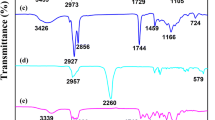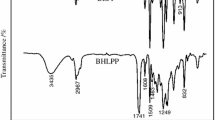Abstract
A series of CO2 copolymer-based waterborne polyurethanes with high solid content were successfully prepared by using CO2 copolymer diol, isophorone diisocyanate, and dimethylol propionic acid as the donors of hydrophilic groups. In order to obtain of the emulsion with high solid content and good physical property, the synthesis conditions of CO2 copolymer-based waterborne polyurethane were studied. The influence of dimethylol propionic acid content and synthesis process on the physical property of the emulsion was also investigated. Results show that CO2 copolymer-based waterborne polyurethane with high solid content can be synthesized by chain expansion at relatively low temperature. The waterborne polyurethane emulsion particle size distribution was wide. As the content of hydrophilic groups in prepolymer increased, the viscosity and water absorption increased obviously, this is difficult to synthesize waterborne polyurethane with high solid content and low water absorption. Thermal gravimetric analysis shows that the higher the chain extending temperature of CO2 copolymer-based waterborne polyurethane, the higher the thermal decomposition temperature. When the CO2 molar content of CO2 copolymer diol is about 30%, the CO2 copolymer-based waterborne polyurethane has high strength and better water resistance.






Similar content being viewed by others
References
Cheng J, Ren J, Lu Y (2020) Application of Eco-Friendly Waterborne Polyurethane Composite Coating Incorporated with Nano Cellulose Crystalline and Silver Nano Particles on Wood Antibacterial Board. Polymers 12:407–418
Bao LH, Sun JX, Li Q (2014) Synthesis and properties of waterborne polyurethane containing spiropyran groups. J Polym Res 21:1–7
Pan DW, Ye HZ, Wang XQ, Zhang Y (2020) Modified geopolymer-based wood adhesive using waterborne polyurethane. BioResources 15:7573–7585
Xian WQ, Song LN, Liu BH, Ding HL, Li Z, Cheng MP, Ma L (2018) Rheological and mechanical properties of thermoplastic polyurethane elastomer derived from CO2 copolymer diol. J Appl Polym Sci 135:45974–45982
Chen WB, Zhang JH, Liu BH (2014) Synthesis and Properties of Poly(Propylene Carbonate) Polyurethane Elastomer. Polym Mater Sci Eng 30:1–5
Xu SP, Zhang M (2007) Synthesis and characterization of a novel polyurethane elastomer based on CO2 copolymer. J Appl Polym Sci 104:3818–3826
Ma L, Song LN, Li F, Wang H, Liu BH (2017) Preparation and properties of poly (propylene carbonate)-based waterborne polyurethane-acrylate composite emulsion. Colloid Polym Sci 295:2299–2307
Orgilés-Calpena E, Arán-Aís F, Torró-Palau AM, Montiel-Parreno E, Orgilés-Barceló C (2016) Synthesis of polyurethanes from CO2-based polyols: A challenge for sustainable adhesives. Int J Adhes Adhes 67:63–68
Langanke J, Wolf A, Hofmann J, Subhani BK, MA, Müller TE, Leitner W, Gürtler C, (2014) Carbon dioxide (CO2) as sustainable feedstock for polyurethane production. Green Chem 16:1865–1870
Liu ZH, Huang JQ, Sun LJ, Lei D, Cao J, Chen S, Shih WC, Qing FL, You ZW (2018) PPCD-based reactive hot melt polyurethane adhesive (RHMPA)—Efficient glues for multiple types of substrates. Chin J Polym Sci 36:58–64
Wang J, Zhang H, Miao YY, Qiao LJ, Wang XH, Wang FS (2016) Waterborne polyurethanes from CO2 based polyols with comprehensive hydrolysis/oxidation resistance. Green Chem 18:524–533
Wang J, Zhang H, Miao YY, Qiao LJ, Wang XH, Wang FS (2016) UV-curable waterborne polyurethane from CO2-polyol with high hydrolysis resistance. Polymer 100:219–226
Geng-hsi W, Shan-hui H (2016) Synthesis of water-based cationic polyurethane for antibacterial and gene delivery applications. Colloid Surface B 146:825–832
Barrioni BR, Carvalho SMD, Orefice RL, Oliveira AAR, Pereira MDM (2015) Synthesis and characterization of biodegradable polyurethane films based on HDI with hydrolyzable crosslinked bonds and a homogeneous structure for biomedical applications. Mat Sci Eng C-Mater 2:22–30
Zhang SF, Wang RM, He YF, Song PF, Wu ZM (2013) Waterborne polyurethane-acrylic copolymers crosslinked core–shell nanoparticles for humidity-sensitive coatings. Prog Org Coat 76:729–735
Han YT, Hu JL, Xin ZY (2019) Facile preparation of high solid content waterborne polyurethane and its application in leather surface finishing. Prog Org Coat 130:8–16
Chai CP, Ma YF, Li GP (2019) The preparation of high solid content waterborne polyurethane by special physical blending. Prog Org Coat 115:79–85
Huang S, Xiao J, Zhu Y (2017) Synthesis and properties of spray-applied high solid content two component polyurethane coatings based on polycaprolactone polyols Prog Org Coat 106:60–68
Qu JL, Wang QJ, Liu LZ (2012) Progress in synthesis of high solid content waterborne polyurethane. Leath Chem ind 29:13–16 + 24
Liu Y, Liang HQ, Li SH, Liu D, Long YJ, Liang GD, Zhu FM (2019) Preparation of waterborne polyurethane with high solid content and elasticity. J Polym Res 26:146–154
Ma L, Song LN, Wang H, Li F, Liu BH (2018) Synthesis and characterization of poly(propylene carbonate) glycol-based waterborne polyurethane with a high solid content. Prog Org Coat 122:38–44
Lee SK, Kim BK (2009) High solid and high stability waterborne polyurethanes via ionic groups in soft segments and chain termini. J Colloid Interface Sci 336:208–214
Hou L, Ding Y, Zhang Z, Sun Z, Shan Z (2015) Synergistic effect of anionic and nonionic monomers on the synthesis of high solid content waterborne polyurethane. Colloid Surface A 467:46–56
Huang S, Xiao J, Zhu Y, Qu JQ (2017) Synthesis and properties of spray-applied high solid content two component polyurethane coatings based on polycaprolactone polyols. Prog Org Coat 106:60–68
Li Q, Wang XM (2019) Synthesis of a water polyurethane emulsion with high solid content, low viscosity via core–shell method. Prog Org Coat 131:435–440
Pérez-Limiñana MA, Arán-Aís F, Torró-Palau AM (2005) Characterization of waterborne polyurethane adhesives containing different amounts of ionic groups. Int J Adhes Adhes 25:507–517
Jang T, Kim HJ, Jang JB, Kim TH, Lee W, Seo B, Ko WB, Lim CS (2021) Synthesis of Waterborne Polyurethane Using Phosphorus-Modified Rigid Polyol and its Physical Properties. Polymers 13:432–441
Nanda AK, Wicks D, Madbouly S, Otaigbe J (2010) Effect of ionic content, solid content, degree of neutralization, and chain extension on aqueous polyurethane dispersions prepared by prepolymer method. J Appl Polym Sci 98:2514–2520
Xie D, Zhang CC, Wang XH, Zhao XJ, Wang FS (2007) End-capping and thermal degradation of poly (propylene carbonate) with different molecular weight. J Wuhan Univ Technol 8:5–9
Hu J, Zhou T, Zhang A (2011) Chain extension of hydroxyl-terminated poly(propylene carbonate) by MDI and its thermal stability. Chin Synth Resin Plast 28:16–19
Mariz I, Leiza JR, Cal J (2011) Competitive particle growth: A tool to control the particle size distribution for the synthesis of high solids content low viscosity latexes. Chem Eng J 168:938–946
Acknowledgements
The authors thanks to the supported from the National Natural Science Foundation of China (Grants: 51873043) and Major science and technology projects of Guangdong Province (2020B090924001).
Author information
Authors and Affiliations
Corresponding authors
Additional information
Publisher's Note
Springer Nature remains neutral with regard to jurisdictional claims in published maps and institutional affiliations.
Rights and permissions
About this article
Cite this article
Xian, W., Yuan, J., Xie, Z. et al. Synthesis and properties of CO2 copolymer-based waterborne polyurethane with high solid content. J Polym Res 28, 254 (2021). https://doi.org/10.1007/s10965-021-02616-9
Received:
Accepted:
Published:
DOI: https://doi.org/10.1007/s10965-021-02616-9




